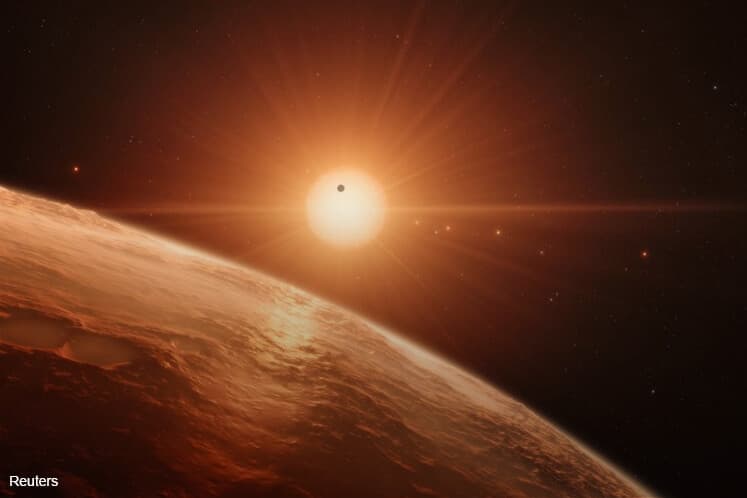
NO event is free of controversy these days — not even the discovery of seven habitable planets that hit the news late last month. For a few days, drawings of those tranquil spheres loomed above the tumult of earthly affairs — the presidential tweets, the protests, the botched Oscars. But then a friend, who happens to be trained as a biologist, wrote to me complaining that by declaring these worlds “habitable,” Nasa’s public relation people were promoting a space-exploration delusion.
He has a point. Like many people who follow astronomy, I would start to take for granted that when astronomers say the word “habitable” they do not actually mean habitable — not in the sense most people use the word, to describe a place where you can go and not die instantly.
This is not to detract from the value of the discovery of seven earth-sized worlds orbiting another star. At a distance of 40 light years, it is in our galactic neighbourhood, so scientists have a shot at detecting atmospheres around the planets. The finding adds to a growing understanding that our galaxy is bursting with planets — astronomers estimate that most of the 100 billion stars in the Milky Way have at least one. But for all practical purposes, they are bad real estate.
Take this new trove. One big problem is that they orbit a dim sun — a dwarf star called Trappist-1, which is about one-twelfth the size of our sun and much cooler. The planets all orbit cozied up to the star, which keeps them from freezing over, but getting a front row seat in your solar system is not a great deal. Such planets get blasted with high-energy radiation, and the gravitational pull of the star probably keeps them from rotating. That means one side gets perpetual sun exposure and the other perpetual darkness. Day, night, morning and evening would be places, not times of day.
Which gets back to why the astronomers refer to them as habitable. By convention, astronomers define “habitable” as “capable of sustaining liquid water.” Life on Earth can exist in extreme conditions — in hot springs, under permanently frozen lakes, in burning acid, or deep underground — but the one common thread is a requirement for liquid water.
There are people who think that definition is too restrictive, said astrobiologist Ariel Anbar of Arizona State University. “They say we’re cutting off the possibility of life as we don’t know it ... But that’s hard to talk about because, well, it’s life as we don’t know it — so we don’t know if it’s there.” It is not that they would turn their noses up if such a life form beamed itself down and asked to be studied. But under such an open-minded definition, just about everything would be habitable. That is not too helpful in narrowing the search.
Scientists cannot actually see any of these planets (the pretty pictures are an artist’s renditions), but they can infer whether they are in what is called a habitable zone. The Trappist-1 planets, for example, were detected by watching the way the star periodically dimmed — a sign that planets are moving in front of it, creating mini-eclipses.
Anbar said planets discovered in the habitable zone might have surface temperatures in a range that could sustain a surface ocean and, in principle, complex life — fuzzy bunnies and the like. Earth bunnies would die instantly, but alien bunnies might be adapted to the conditions.
There are also places outside the official habitable zone, warmed by tidal or volcanic forces, that might support simple life, he said. Scientists do not rule out life under the icy crust of Jupiter’s moon Europa — but it is unlikely to take the form of bunnies.
But do not get your hopes up that astronomers will find new home planets in case we continue to screw up our own. “There isn’t likely to be any planet in the universe that’s habitable in the sense that you and I can just show up and start drinking the water and eating the fruit,” said David Grinspoon, an astrobiologist from the Planetary Science Institute in Arizona.
This is not an unusually pessimistic view. Even our own Earth was not habitable by human standards for most of its 4.5 billion-year history. If you had a time machine and went back more than about a half a billion years, you would die. The atmosphere would be toxic. There would be life here, as there has been for about 3.8 billion years, but it would be adapted to a very different atmosphere.
Our planet’s complex mix of minerals and atmospheric gases and landscapes and temperatures seems perfectly tuned for us, but that is an illusion. We are the ones tuned by evolution to live on this particular planet in this particular era. Living things changed the planet — most dramatically when photosynthetic plants starting filling the atmosphere with oxygen. And in turn life had to readjust to an altered planet. “Life and the planet have co-evolved,” said Grinspoon, who is author of the book Earth in Human Hands.
The real universe is not as human-friendly as it looked on Star Trek, where many of the aliens conveniently spoke English. On the flip side, space aliens would probably find Earth a hostile environment, even if they had the good sense to aim for Canada. While there may be countless planets that are habitable for aliens, this may be the only one that is habitable for us. — Bloomberg